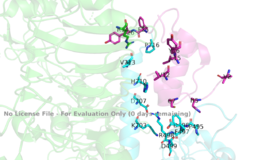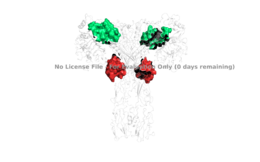Sandbox Reserved 1627
From Proteopedia
(Difference between revisions)
| Line 10: | Line 10: | ||
====Alpha Subunits==== | ====Alpha Subunits==== | ||
| - | + | The alpha subunits make up the extracellular domain ([http://en.wikipedia.org/wiki/Ectodomain ectodomain]) of the insulin receptor and are the sites of insulin binding. The alpha subunit is comprised of two Leucine rich domains (L1 & L2), a Cysteine rich domain (CR), and a C-terminal alpha helix. The alpha subunits are held together by a [http://en.wikipedia.org/wiki/Disulfide disulfide bond] between <scene name='83/832953/Cysteine_bond/1'>cysteine residues</scene> at the CYS524 position on each alpha subunit. Two types of insulin binding sites are present in the alpha subunits, <scene name='83/832953/Sites_1_and_1_prime_location/15'>sites 1 and 1'</scene> and <scene name='83/832953/Sites_2_and_2_prime_location/12'>sites 2 and 2'</scene>. The sites are in pairs because of the heterodimeric nature of the receptor. Due to structural differences, as well as greater surface area and accessibility, binding sites 1 and 1' have much higher affinity than that of sites 2 and 2'. Insulin can also bind at sites 2 and 2', but the location on the back of the beta sheet of the FnIII-1 domain and lack of surface area decreases the likelihood of their binding site becoming occupied as quickly. <ref name="Uchikawa"> DOI 10.7554/eLife.48630 </ref> Cryo-EM has imaged insulin bound structures that displayed a T-shape conformation in the alpha subunits.<ref name="Uchikawa" /> | |
| - | The alpha subunits make up the extracellular domain ([http://en.wikipedia.org/wiki/Ectodomain ectodomain]) of the insulin receptor and are the sites of insulin binding. The alpha subunit is comprised of two Leucine rich domains (L1 & L2), a Cysteine rich domain (CR), and a C-terminal alpha helix. The alpha subunits are held together by a [http://en.wikipedia.org/wiki/Disulfide disulfide bond] between <scene name='83/832953/Cysteine_bond/1'>cysteine residues</scene> at the CYS524 position on each alpha subunit | + | |
===Beta Subunits=== | ===Beta Subunits=== | ||
| - | The beta subunit spans from the extracellular domain across the transmembrane region and into the intracellular portion of the insulin receptor. The beta subunit is composed of part of [http://en.wikipedia.org/wiki/Fibronectin fibronectin] domain III-2 and all of Fibronectin domain III-3. The beta subunit's FnIII-3 domain has links through the transmembrane region into the intracellular part of the membrane.[http://en.wikipedia.org/wiki/Transmission_electron_cryomicroscopy Cryo-EM] results have displayed clear representations of FnIII-2 and FnIII-3 domains, but lack in their ability to model the receptor structure throughout the transmembrane region and intracellular region. | + | The beta subunit spans from the extracellular domain across the transmembrane region and into the intracellular portion of the insulin receptor. The beta subunit is composed of part of [http://en.wikipedia.org/wiki/Fibronectin fibronectin] domain III-2 and all of Fibronectin domain III-3. The beta subunit's FnIII-3 domain has links through the transmembrane region into the intracellular part of the membrane.[http://en.wikipedia.org/wiki/Transmission_electron_cryomicroscopy Cryo-EM] results have displayed clear representations of FnIII-2 and FnIII-3 domains, but lack in their ability to model the receptor structure throughout the transmembrane region and intracellular region. Although, the FnIII-3 domain is connected to these regions, so it has been proposed that the T-shape conformation extends all the way to the tyrosine kinase domain region. [[https//www.rcsb.org/structure/1ir3 PDB 1IR3]] |
== Function== | == Function== | ||
| - | The insulin receptor's structure is critical to it's function. The receptor | + | The insulin receptor's structure is critical to it's function. The receptor's ability to change shape is what initiates the signaling pathway that will eventually move glucose transporters to the cell surface, allowing glucose to passively defuse into the cell. |
===Activation by Insulin=== | ===Activation by Insulin=== | ||
| - | + | Insulin is a [http://en.wikipedia.org/wiki/Peptide_hormone peptide hormone] produced and secreted from the [http://en.wikipedia.org/wiki/Pancreatic_islets islets of Langerhans] of the pancreas in response to high blood glucose levels. Insulin is commonly considered the anabolic hormone of the body, and is the an important [http://en.wikipedia.org/wiki/Ligand ligand] in glucose homeostasis. The structure of <scene name='83/832953/Insulin_ligand/1'>insulin</scene> is a simple monomer composed of two peptide chains linked by intermolecular disulfide bridges. Without insulin, the glucose receptors cannot be brought to the surface of the membrane to take in excess glucose in the blood, which means they are inactive. The body has a mechanism in place to upregulate the production of insulin in the presence of a surplus of glucose circulating in the blood stream. The binding of the increased amount of insulin to the insulin receptors will activate their downstream pathways to initiate glucose uptake by the phosphorylation of the [http://en.wikipedia.org/wiki/Insulin_receptor_substrate Insulin Receptor Substrate] (IRS). The transport of extracellular glucose into the cell allows it to be converted to [http://en.wikipedia.org/wiki/Glycogen glycogen] for storage and later usage. | |
===Conformation Change=== | ===Conformation Change=== | ||
| - | + | Upon activation, the receptor undergoes a structural [http://en.wikipedia.org/wiki/Conformational_change conformation change] from the inactive <scene name='83/832953/Inactive_insulin_receptor/3'>inverted V</scene> state to the active <scene name='83/832953/Ir_dimer_t_state/3'>T shape</scene> state. When the receptor is in a V shape, the FnIII-3 domains are separated by about 120Å. This distance prevents the initiation of autophosphorylation and downstream signaling by the tyrosine kinase domains on the intracellular side of the receptor. Upon the binding of insulin to three binding sites, 1, 1', and either 2 or 2', the conformation change will begin and bring the FnIII-3 domains within 40Å of each other to induce the T-state conformation. <ref> DOI 10.1038/s41467-018-06826-6</ref> <ref name="Uchikawa" /> The T shape conformation is well observed in the alpha subunit. It is horizontally composed of L1, CR (including the alpha-CT chain), and L2 domains and vertically composed of the FnIII-1, 2, and 3 domains. This structural transition will facilitate the autophosphorylation of the tyrosine kinase domain. | |
===Binding interactions=== | ===Binding interactions=== | ||
[[Image:Binding site with AA labeled.png|thumb|right|270px|Figure 3: Subunit interactions between the insulin receptor CT-alpha helix (light blue) and insulin (magenta) in one of the binding sites. [http://www.rcsb.org/structure/6sof PDB 6SOF]]] | [[Image:Binding site with AA labeled.png|thumb|right|270px|Figure 3: Subunit interactions between the insulin receptor CT-alpha helix (light blue) and insulin (magenta) in one of the binding sites. [http://www.rcsb.org/structure/6sof PDB 6SOF]]] | ||
| + | |||
| + | The actual site of insulin binding occurs at the <scene name='83/832953/Alpha_c_helix/5'>α-CT chain</scene> of one of the sites discussed next and is stabilized by the L1 and L2 domains. | ||
| + | |||
| + | "Cross linking" | ||
| + | |||
A tripartite interaction occurs between the alpha-CT chain and the FnIII-1 domain region during the conformational change. This interaction involves the following residues: <scene name='83/832953/Alpha_ct_and_fniii-1/7'>ASP496, ARG498, and ASP499 on the FnIII-1 domain</scene> and the <scene name='83/832953/Alpha_ct_and_fniii-1/9'>LYS703, GLU706, and ASP707 on the alpha-CT domain</scene>. This duo then interacts with the leucine rich region, L1, that exists on the opposing protomer of the dimer. The tripartite interaction between the alpha-CT chain and FnIII-1 domain on one dimer and the L1 region on the other dimer is important because it allows for a strong and stable interaction between two dimers of the insulin receptor that maintains the T-shape activation state for the rest of the downstream signaling to occur. | A tripartite interaction occurs between the alpha-CT chain and the FnIII-1 domain region during the conformational change. This interaction involves the following residues: <scene name='83/832953/Alpha_ct_and_fniii-1/7'>ASP496, ARG498, and ASP499 on the FnIII-1 domain</scene> and the <scene name='83/832953/Alpha_ct_and_fniii-1/9'>LYS703, GLU706, and ASP707 on the alpha-CT domain</scene>. This duo then interacts with the leucine rich region, L1, that exists on the opposing protomer of the dimer. The tripartite interaction between the alpha-CT chain and FnIII-1 domain on one dimer and the L1 region on the other dimer is important because it allows for a strong and stable interaction between two dimers of the insulin receptor that maintains the T-shape activation state for the rest of the downstream signaling to occur. | ||
Revision as of 00:54, 18 April 2020
Homo sapiens Insulin Receptor
| |||||||||||
References
- ↑ 1.0 1.1 De Meyts P. The Insulin Receptor and Its Signal Transduction Network PMID:27512793
- ↑ 2.0 2.1 2.2 Tatulian SA. Structural Dynamics of Insulin Receptor and Transmembrane Signaling. Biochemistry. 2015 Sep 15;54(36):5523-32. doi: 10.1021/acs.biochem.5b00805. Epub , 2015 Sep 3. PMID:26322622 doi:http://dx.doi.org/10.1021/acs.biochem.5b00805
- ↑ 3.0 3.1 3.2 Uchikawa E, Choi E, Shang G, Yu H, Bai XC. Activation mechanism of the insulin receptor revealed by cryo-EM structure of the fully liganded receptor-ligand complex. Elife. 2019 Aug 22;8. pii: 48630. doi: 10.7554/eLife.48630. PMID:31436533 doi:http://dx.doi.org/10.7554/eLife.48630
- ↑ Weis F, Menting JG, Margetts MB, Chan SJ, Xu Y, Tennagels N, Wohlfart P, Langer T, Muller CW, Dreyer MK, Lawrence MC. The signalling conformation of the insulin receptor ectodomain. Nat Commun. 2018 Oct 24;9(1):4420. doi: 10.1038/s41467-018-06826-6. PMID:30356040 doi:http://dx.doi.org/10.1038/s41467-018-06826-6
- ↑ Uchikawa E, Choi E, Shang G, Yu H, Bai XC. Activation mechanism of the insulin receptor revealed by cryo-EM structure of the fully liganded receptor-ligand complex. Elife. 2019 Aug 22;8. pii: 48630. doi: 10.7554/eLife.48630. PMID:31436533 doi:http://dx.doi.org/10.7554/eLife.48630
- ↑ Boucher J, Kleinridders A, Kahn CR. Insulin receptor signaling in normal and insulin-resistant states. Cold Spring Harb Perspect Biol. 2014 Jan 1;6(1). pii: 6/1/a009191. doi:, 10.1101/cshperspect.a009191. PMID:24384568 doi:http://dx.doi.org/10.1101/cshperspect.a009191
- ↑ Wilcox G. Insulin and insulin resistance. Clin Biochem Rev. 2005 May;26(2):19-39. PMID:16278749
- ↑ Riddle MC. Treatment of diabetes with insulin. From art to science. West J Med. 1983 Jun;138(6):838-46. PMID:6351440
Student Contributors
- Harrison Smith
- Alyssa Ritter


